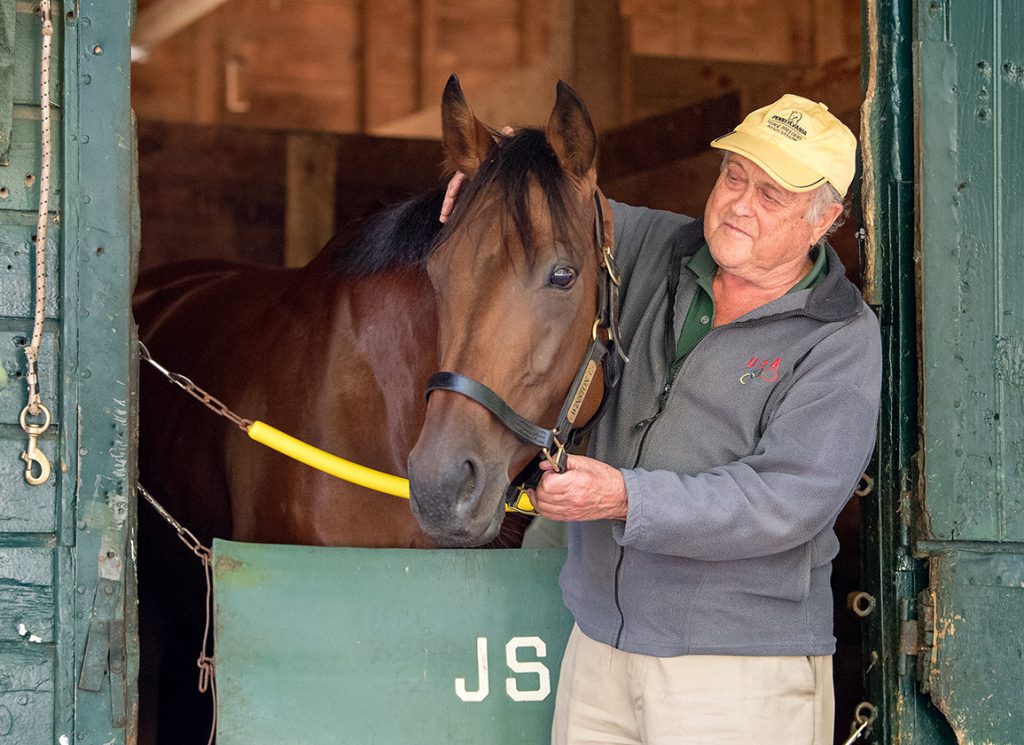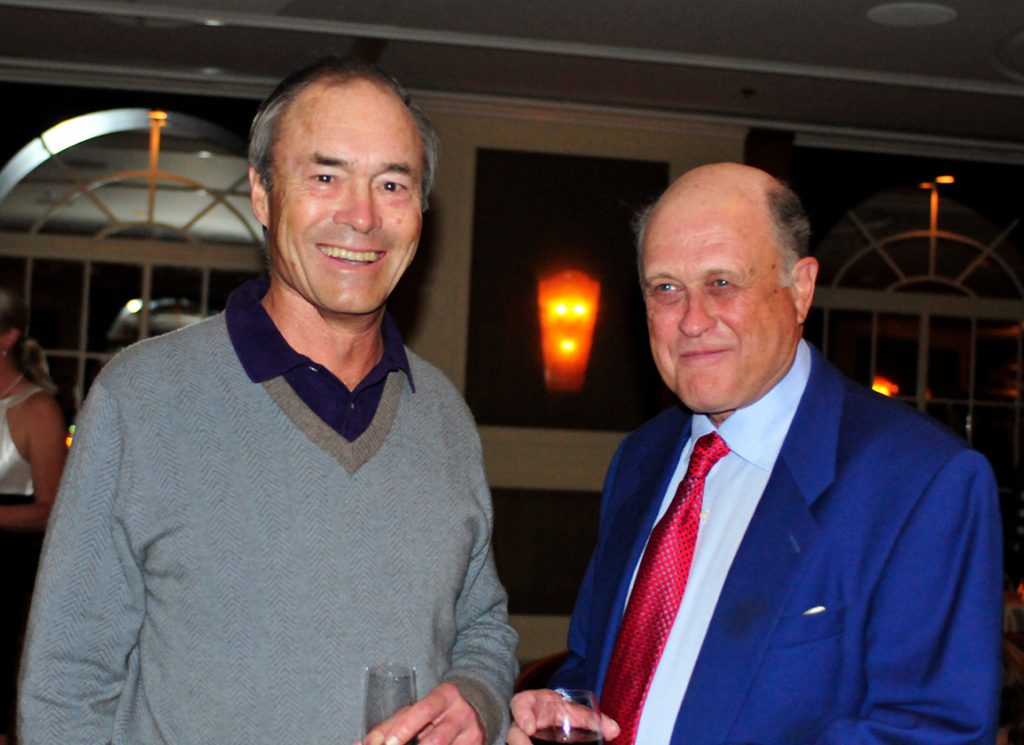By Don Clippinger
Jonathan Sheppard, an acclaimed Racing Hall of Fame trainer whose accomplishments extended from steeplechase race meets to the highest levels of Thoroughbred racing, died Sunday, Aug. 27, at his home in Hollywood, Fla. He was 82.
The British-born horseman had retired from training early in 2021 with records that will, in several instances, stand forever. He was the National Steeplechase Association's all-time leading trainer by wins with 1,242 victories beginning in 1966, and his horses earned almost $25-million on the jumps circuit. Both are records.
He was the steeplechase sport's leading trainer by wins a record 26 times, and he led the earnings table 29 times, also a record. His first training title was in 1972, a spare six years after his first win, and his final championships, by wins and earnings, were in 2020, the pandemic-shortened season that concluded his training career.
His horses competed at the highest levels, and two of them also have plaques in the Racing Hall of Fame in Saratoga Springs, N.Y: Augustin Stables' Cafe Prince and Flatterer, who raced for longtime owner William Pape, bloodstock agent George Harris, and Sheppard.
Over fences and on the flat, Sheppard had 3,426 victories from 20,997 starts and earnings of $88.7-million, according to Equibase records. He was inducted into the Racing Hall of Fame in 1990.
In all, Sheppard trained 11 individual Eclipse Award winners who collected a total of 15 championships. Flatterer, among the best American steeplechase horses of all time, accounted for four consecutive titles between 1983 and 1986. The Mo Bay gelding, bred by Pape and Sheppard, also finished second in the French and English champion hurdle races in overseas forays.
Two Sheppard-trained Augustin horses recorded titles on the flat: Forever Together was the champion turf female in 2008, and Informed Decision was the following year's champion female sprinter.
His most notable flat horse missed a championship by a couple inches. William T. Young sent two-year-old Storm Cat to Sheppard in 1985, and the Storm Bird colt blossomed while galloped by Sheppard's wife, retired jockey Cathy Montgomery Sheppard.
That fall, Storm Cat won the Young America Stakes, a Grade 1 race at the Meadowlands, and he just failed to hold off Tasso in the Breeders' Cup Juvenile (G1) at Aqueduct Race Course, finishing second by a nose. Tasso subsequently was voted the year's champion two-year-old male.
At the suggestion of Cathy and Jonathan Sheppard, Young retired Storm Cat to the owner's Overbrook Farm in Kentucky, and the son of Storm Bird was North America's leading sire in 1999 and 2000. One of America's most sought-after stallions in that era, Storm Cat led the juvenile sire list a record seven times, and his stud fee rose to $500,000 in 2002.
One measure of Sheppard's success was his record at one of the most difficult places in the world to win a horse race, Saratoga Race Course. Sheppard won at least one race at Saratoga for an unprecedented 47 straight years, through 2015. The New York Racing Association named one of its two Grade 1 steeplechase races at Saratoga for him in 2021.
The diversity of Sheppard's champions—over fences, on the turf, and in dirt sprints—underlines the multiple talents of their trainer. But Sheppard also was a trainer of horsemen. One of his first assistant trainers, Janet Elliot, became the first woman to win a steeplechase training title, in 1991, and the first female trainer inducted into the Racing Hall of Fame, in 2009.
Another former assistant, Graham Motion, saddled Animal Kingdom to victories in the Kentucky Derby and Dubai World Cup. Based at the Fair Hill Training Center in Maryland, Motion has more than 2,500 victories to his credit and was a Hall of Fame nominee in 2023.
Leslie Young, who worked for Sheppard before and after college, was steeplechasing's champion trainer in 2022 with 37 victories, and former Sheppard assistant Keri Brion was the leading jumps trainer by 2022 earnings, with more than $1.1-million in purses.
Sheppard provided leadership in other ways. He was the National Steeplechase Association's president from 2004 to 2006, and he received steeplechasing's highest honor, the F. Ambrose Clark Award, in 2013 for his contributions to the sport.
He imparted his knowledge and wisdom willingly and was always the go-to interview for journalists who often encountered only one day of horse racing a year. On rare occasion, he invited racing journalists to ride out with his horses at Ashwell Stable in West Grove, Pa.
Although he might occasionally grouse privately to race officials, he always provided a positive outlook to the sport in public. One example was when one of his top horses, Arcadius, collapsed and died after winning the 2012 Iroquois Stakes in Nashville. While some trainers might have retired to the barn after such a devastating loss, Sheppard met with the media and explained how blood-vessel ruptures in the heart and major arteries can on rare occasion result in a sudden death.
Sheppard also was an innovator in many ways, especially in training many of his racetrack horses on the farm. While steeplechase horses commonly are trained in a country setting, flat horses usually are housed at the racetracks where they raced.
Although Sheppard annually had a barn at Saratoga, many of his flat horses had their major preparations at Ashwell, about 35 miles west of Philadelphia. When Sheppard began training, stable size usually was limited to the number of stalls a trainer obtained at his or her main base, commonly 40.
Sheppard's stable usually was much larger, numbering more than 70 in the early 1980s. In that era, Hall of Fame trainers Jack Van Berg and D. Wayne Lukas had similarly large operations spread over multiple racetracks.
Both trends—country locations and large stables—reflected training practices in his native England. Jonathan Eustace Sheppard was born Dec. 2, 1940 in Ashwell, a Herefordshire hamlet about 45 miles north of London, to Daniel and Cynthia Sheppard. One of four children, he was raised around horses and became an accomplished jockey in point-to-point races, which were serious but unsanctioned race meets resembling America's steeplechase meets.
He could not progress beyond the point-to-points, however. Daniel Sheppard was a senior official of the Jockey Club in England, and conflict-of-interest rules limited the younger Sheppard's opportunities in sanctioned races. Also, he lacked the financial resources to begin training in his home country.
Sheppard traveled to the United States in the early 1960s and rode for Hall of Fame steeplechase trainer W. Burling Cocks. After a couple seasons, Sheppard returned home but came back to the United States in 1965 to see if he could succeed as a steeplechase trainer.
He would succeed beyond anyone's wildest dreams, although integrity and honesty rather than a bunch of early winners determined the trajectory of his career. In 1965, he had met George Strawbridge Jr., a scion of the Campbell Soup Co. family who was an accomplished amateur steeplechase jockey and wanted to spread his wings as an owner in the Augustin silks.
Early in their partnership, a Strawbridge horse sustained a leg injury in a race. Sheppard volunteered that the horse's bandages may have been too tight and jumping boots may have been applied incorrectly.
Strawbridge said in a late-1970s interview that he was impressed with Sheppard's forthright admission, and their relationship took off. Strawbridge's Augustin operation was steeplechasing's leading owner a record 23 times beginning in 1974.
Bill Pape, a well-known Long Island auto dealer, also joined the Sheppard team as he expanded his racing operation in the late 1960s, and they accounted for five Eclipse steeplechase champions over 40 years, from Athenian Idol in 1973 to Divine Fortune in 2013.
Behind Sheppard's gentle demeanor and lilting Etonian accent was a hard-working, highly motivated horseman who strived to outwork his competition. From his Ashwell base, he drove to tracks where he had horses stabled and where he saddled his starters. On at least one occasion, he was pulled over for studying Daily Racing Form past performances while driving on a major highway.
Both his work ethic and his accomplishments earned him a rare honor, one that will never be documented in any record book. In the steeplechase world, he was known by his first name alone. Say “Jonathan” to anyone in the jumps community, and the reference was immediately understood.
In that milieu, there was only one Jonathan, Jonathan Sheppard.
His death was attributed to complications from late-stage Lyme Disease. In addition to his wife of 33 years, he is survived by three children from previous marriages. Funeral services will be private, and a celebration of his life will be scheduled at a later date.
In his memory, donations to injured-jockey and racehorse-retirement charities are suggested.
Not a subscriber? Click here to sign up for the daily PDF or alerts.








